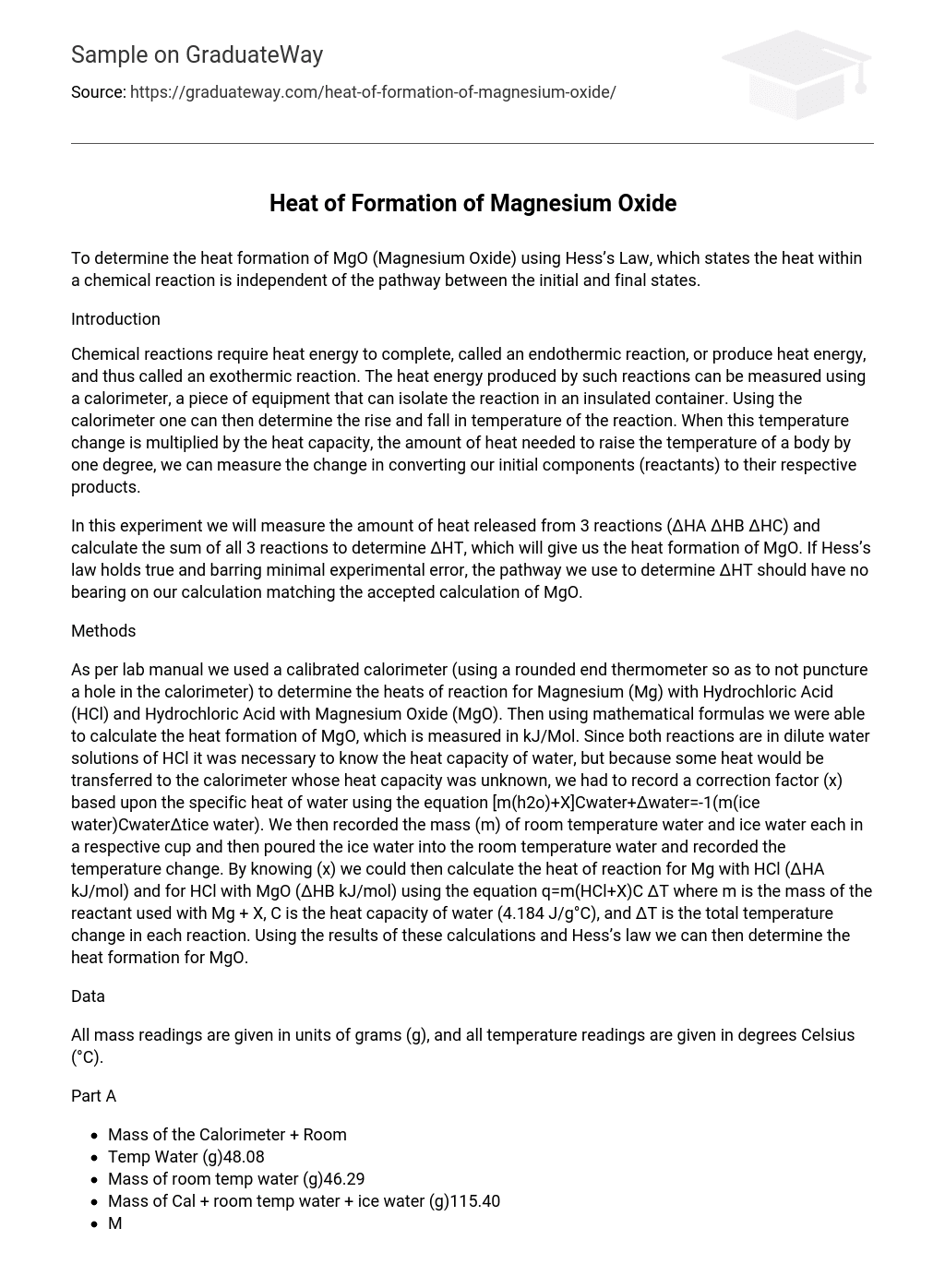To determine the heat formation of MgO (Magnesium Oxide) using Hess’s Law, which states the heat within a chemical reaction is independent of the pathway between the initial and final states.
Introduction
Chemical reactions require heat energy to complete, called an endothermic reaction, or produce heat energy, and thus called an exothermic reaction. The heat energy produced by such reactions can be measured using a calorimeter, a piece of equipment that can isolate the reaction in an insulated container. Using the calorimeter one can then determine the rise and fall in temperature of the reaction. When this temperature change is multiplied by the heat capacity, the amount of heat needed to raise the temperature of a body by one degree, we can measure the change in converting our initial components (reactants) to their respective products.
In this experiment we will measure the amount of heat released from 3 reactions (ΔHA ΔHB ΔHC) and calculate the sum of all 3 reactions to determine ΔHT, which will give us the heat formation of MgO. If Hess’s law holds true and barring minimal experimental error, the pathway we use to determine ΔHT should have no bearing on our calculation matching the accepted calculation of MgO.
Methods
As per lab manual we used a calibrated calorimeter (using a rounded end thermometer so as to not puncture a hole in the calorimeter) to determine the heats of reaction for Magnesium (Mg) with Hydrochloric Acid (HCl) and Hydrochloric Acid with Magnesium Oxide (MgO). Then using mathematical formulas we were able to calculate the heat formation of MgO, which is measured in kJ/Mol. Since both reactions are in dilute water solutions of HCl it was necessary to know the heat capacity of water, but because some heat would be transferred to the calorimeter whose heat capacity was unknown, we had to record a correction factor (x) based upon the specific heat of water using the equation [m(h2o)+X]Cwater+Δwater=-1(m(ice water)CwaterΔtice water). We then recorded the mass (m) of room temperature water and ice water each in a respective cup and then poured the ice water into the room temperature water and recorded the temperature change. By knowing (x) we could then calculate the heat of reaction for Mg with HCl (ΔHA kJ/mol) and for HCl with MgO (ΔHB kJ/mol) using the equation q=m(HCl+X)C ΔT where m is the mass of the reactant used with Mg + X, C is the heat capacity of water (4.184 J/g°C), and ΔT is the total temperature change in each reaction. Using the results of these calculations and Hess’s law we can then determine the heat formation for MgO.
Data
All mass readings are given in units of grams (g), and all temperature readings are given in degrees Celsius (°C).
Part A
- Mass of the Calorimeter + Room
- Temp Water (g)48.08
- Mass of room temp water (g)46.29
- Mass of Cal + room temp water + ice water (g)115.40
- Mass of ice water (g)67.32
- Temp of room temp water (°C)42.4
- Temp of the ice water (°C)0.1
- Final temp. of room temp water (°C)17.3
- Change in temp of ice water (°C)17.2
- Change of temp of room temp water (°C)-25.1
- Mass of the calorimeter (g)1.79
Part 2A
- Mass of Calorimeter (g)1.79
- Mass of Cal + HCl (g)103.55
- Mass of HCL (g)101.76
- Mass of Mg (g)0.5
- Temperature of HCl (°C)20.3
- Final temperature of HCl + Mg (°C)42.0
- Change in Temperature (°C)21.7
Part B
- Mass of Calorimeter (g)1.79
- Mass of Cal + HCl (g)101.76
- Mass of HCl (g)99.88
- Mass of MgO (g)0.8
- Temperature of HCl (°C)20.3
- Final temperature of HCl + MgO (°C)25.8
- Change in Temperature (°C)5.50
Results and Discussion
To calculate X using the equation [m(h2o)+X]Cwater+Δwater=-1(m(ice water)CwaterΔtice water) the variable X must be isolated and doing so we were than able to calculate the correction factor:
Based on the calculations of the calorimeter correction factor, X was determined to be 0.158 g. Then using the equation q=m(HCl+X)C *ΔT, where q is equal to the amount of energy given off, and than calculating the value in -kJ/Mol (because these are exothermic reactions) we were able to determine ΔHA and ΔHB.
qA=m(HCl+X)C xΔT
qA=(101.76 g + 0.158 g) x 4.184 J/g°C x 21.7°C
qA= 9250 J = 9.250 kJ 9.253602176
qB= m(HCl+X)C xΔT
qB=(101.76 g + 0.158 g) x 4.184 J/g°C x 5.50°C
qB=2350 J = 2.350 kJ
To then calculate the heat formation of MgO ΔHT, the sum of all the reactions must be determined including ΔHC, the heat formation of water, which is already predetermined to be -285.8 kJ/mol. However to determine the proper equation for ΔHT, the stoichiometric equations must first be balanced:
Therefore the heat formation of MgO was determined to be -618.35 kJ/mol. According to the textbook, the accepted value for ΔHT=-601.8 kJ/mol. To determine the accuracy of the calculation we can determine the % error:
As far as accuracy goes a percent error of 2.75% is very acceptable. Because the methods of the experiment were conducted using a crude calorimeter I would have expected the percent error to be higher, assuming that because of it’s construction it would not have very high efficiency.
I would expect that any error that might have occurred happened during the transference from one cup to another. Because the substances were transferred so quickly and taking into account the number of seconds that it took to replace the thermometer to begin recording data again it is possible that energy was either lost in the transfer or energy was lost before the recording was actually able to begin.
Conclusion
In this lab we were able to determine the heat of formation of MgO using a simply constructed calorimeter, which was found to be -618.35 kJ/mol.





